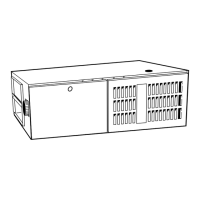7
5. Wash filter (if dirty) in sink, bathtub, or outside with a gar-
den hose. Always use cold tap water. A mild liquid deter-
gent may be used if necessary. Spray water through filter
in the opposite direction of airflow. Allow filter to dry.
6. Reinstall clean air filter
7. Reinstall filter retainer (for blower compartment locations
only)
8. Replace control and blower doors (See Fig. 26 and 16) or
filter cabinet door (Fig. 34 and 35)
9. Turn on electrical supply to furnace (see Fig 18).
NOTE:
Two filters may be required in some upflow models if
side return ducts are used. The procedure listed above
may be used to remove side filters.
•
Downflow/Horizontal Furnaces Only:
Two filters are located in the return-air plenum above the
blower (above line-of-sight) resting in the V-shaped channel
on top of the furnace. (See Fig. 27.)
1. Turn off electrical supply to the furnace. (See Fig. 21.)
2. Remove 2 screws from blower access door and remove
the door.
3. Remove the left-side filter by tipping the filter toward
the center and raising it from the V-shaped channel in
which it rests. (See Fig. 27 and 28.)
4. Lower filter down along side of the blower and remove
from the furnace.
5. To remove the right-side filter, lift from V-shaped channel
and remove through left side the same way as left-side filter.
6. Inspect the filter. If torn, replace the filter.
7. Wash the filter (if dirty) in a sink, bathtub, or outside
with a garden hose. Always use cold tap water. A mild
liquid detergent may be used if necessary. Spray water
through the filter in opposite direction of airflow
through the cross-mesh binding (when present) side.
Allow filter to dry.
8. Reinstall the clean filters.
27 28
9. Replace blower door and secure with 2 screws. Turn
on electrical supply to your furnace. (See Fig. 18.
* Factory provided with the furnace. Filters may be field modified by cutting
filter material and support rods (3) in filters. Alternate sizes and additional
filters may be ordered from your dealer.
COMBUSTION AREA AND
VENT SYSTEM
Inspect the combustion area and vent system before each
heating season. An accumulation of dirt, soot, or rust can
mean a loss of efficiency and improper performance.
Buildups on the main burners can cause faulty firing. This
“delayed ignition’’ is characterized by an alarmingly
loud sound. If your furnace makes a loud noise when the
main burners are ignited, shut down the furnace and call
your servicing dealer.
Use your flashlight and follow these steps for inspecting
the combustion area and vent system of your furnace:
1. Turn off electrical supply to the furnace and remove
the access doors. (See Fig. 9, and 10 or 11.)
2. Carefully inspect the gas burner for dirt, rust, or scale
(see Fig. 29). Inspect the relief box, flue connection
area, and the vent pipe for rust.
UPFLOW/HORIZONTAL FURNACE AIR FILTER TABLE
AIR FILTER LOCATED IN BLOWER COMPARTMENT
FURNACE
CASING
WIDTH (IN.)
FILTER SIZE (IN)
FILTER
TYPESide Return Bottom Return
14-3/16 (1) 16 x 25 x 1* (1) 14 x 25 x 1 Cleanable
17-1/2 (1) 16 x 25 x 1* (1) 16 x 25 x 1* Cleanable
21 (1) 16 x 25 x 1 (1) 20 x 25 x 1* Cleanable
24-1/2 (1 or 2) 16 x 25 x 1 (1) 24 x 25 x 1* Cleanable
AIR FILTER LOCATED IN FILTER CABINET
FILTER
CABINET
HEIGHT (IN)
FILTER
SIZE (IN)
FILTER
TYPE
16 (1) 16 x 25 x 1*
or (1) 16 x 25 x 4-5/16
Cleanable
Disposable
20 (1) 20 x 25 x 1*
or (1) 20 x 25 x 4-5/16
Cleanable
Disposable
24 (1) 24 x 25 x 1*
or (1) 24 x 25 x 4-5/16
Cleanable
Disposable
DOWNFLOW/HORIZONTAL
FURNACE FILTER TABLE (IN.)
FURNACE CASING
WIDTH FILTER SIZE (IN)
FILTER
TYPE
14-3/16 (2) 16 x 20 x 1* Cleanable
17-1/2 (2) 16 x 20 x 1* Cleanable
21 (2) 16 x 20 x 1* Cleanable
24-1/2 (2) 16 x 20 x 1* Cleanable
CAUTION
Use care when cutting support rods in filters to
protect against flying pieces and sharp rod ends.
Wear safety glasses, gloves, and appropriate pro-
tective clothing. Failure to follow this caution
could result in personal injury.
!

